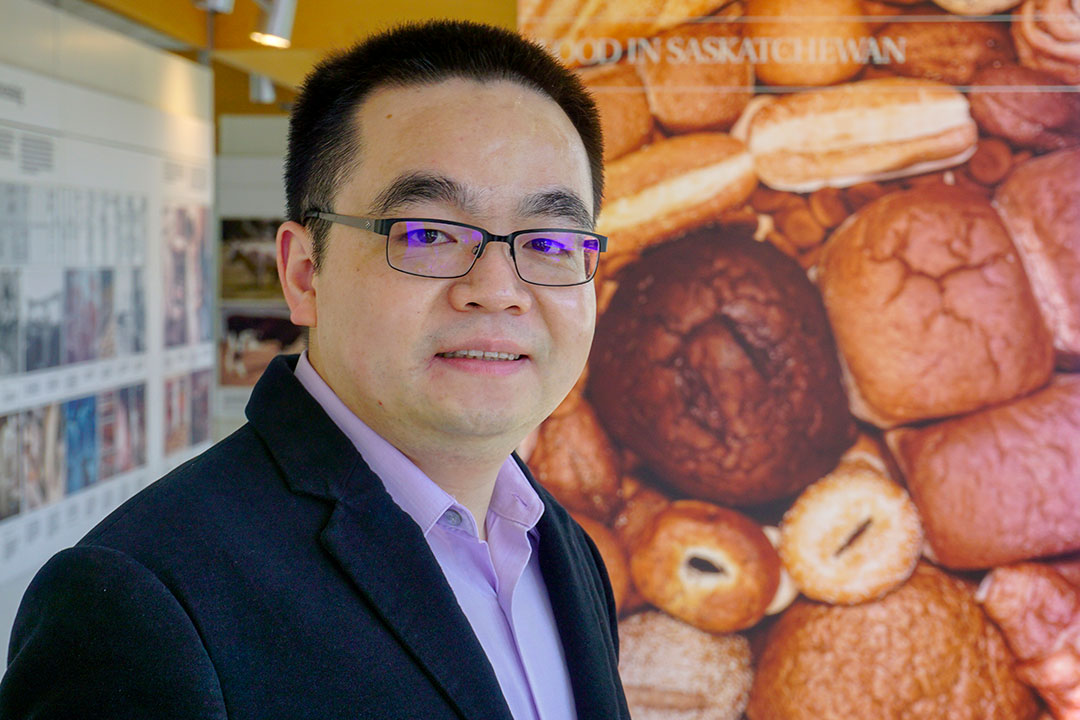
Unique chemistry
For an academic with a long-standing interest in carbohydrates, the predominant component in cereal and pulse crops, there may be no better place in the world to conduct research into their chemistry and health benefits than in a city surrounded by fields where those crops are grown.
By Colleen MacPhersonDr. Yongfeng Ai (PhD) arrived at the College of Agriculture and Bioresources almost four years ago, to a new position, a blank slate and an empty lab. He has gone on to build a diverse and robust research program focused on producing healthy complex carbohydrates from Saskatchewan-grown crops like peas and lentils, but also on broadening the potential of carbohydrates as ingredients in human and pet foods.
“Food is a universal language with strong ties to our daily life and health,” said Ai. “What we eat and how the food we eat affects our health have always intrigued me.”
His interest in biology and chemistry came together naturally in the area of food science, and Ai developed a particular interest in starch as an undergraduate student in China. An internship with a global starch company there exposed him to the world of possibilities for what is most commonly known as a food ingredient but also has important industrial applications in paper and textile production.
Ai earned a PhD in carbohydrate chemistry at Iowa State University, then held a post-doctoral position at Michigan State University doing cereal grain science. When a friend sent him the posting for an assistant professorship and the Saskatchewan Ministry of Agriculture Endowed Research Chair in Carbohydrate Quality and Utilization in the Department of Food and Bioproduct Sciences at the University of Saskatchewan, it seemed almost too good to be true. “It allowed me to carry all of my passion and knowledge into the position.”
His research program falls into three main areas that intersect with the food chain from one end to the other, from collaborating with plant breeders in the college to sharing knowledge and techniques with ingredient producers and food processors. One of Ai’s main research areas is carbohydrate modification and utilization.
He explained there is an increased use of Saskatchewan-grown crops like peas, lentils and faba beans to produce high-quality protein but a co-product of that process is starch. “Our goal is to find ways to use that starch to generate new value, and to improve both its food and industrial applications.”
Maize and tapioca starch currently hold a significant share of the global market, he said, “but I think there’s room for pulse starch, and starch from oats, quinoa and other Saskatchewan crops, as a new source of food ingredients.”
Working with the Saskatchewan Agri-Food Innovation Centre and other industry partners, Ai and his research colleagues are evaluating the performance of pulse starch, looking in particular at how they function as a food ingredient as well as their glycemic response, the effect a food has on blood sugar level after consumption.
“We want to collect more solid data that we can use to convince the industry that pulse starch is a good alternative to maize and other starch. There’s a lot of work to do, but we’ve made good progress.”
In conjunction with this work is an effort to address a new trend—clean-label ingredients. “When starch is modified using a chemical method, it must be listed on food labels as ‘modified starch’,” said Ai. He is investigating non-chemical modification methods which would allow the ingredients to be listed simply as ‘starch’, the new preference.
“Processors don’t want ingredients that sound like a chemical. We’re using new physical and enzymatic methods to generate clean-label starch to meet this new demand.”
Ai’s research also zeros in on carbohydrate nutrition, work driven by the demand for low-glycemic foods in the face of rising rates of diabetes and obesity around the world. “People are looking for food that is low glycemic and the exciting part is that in our province, we have all the low-glycemic pulses.”
With his expertise in producing healthy complex carbohydrates, Ai has partnered with other researchers to conduct three feeding studies to explore the glycemic response and digestibility of Saskatchewan-grown crops in food. One human trial will involve peas, lentils and oats; a second one will diverse varieties of peas.
In the third study, he has teamed up with Dr. Lynn Weber of the Western College of Veterinary Medicine and her pack of research beagles to assess the nutritional benefits of low-glycemic pet food developed by his program. According to Ai, more than 50 per cent of dogs and cats in North America are overweight or obese, so the need to more fully understand the nutritional value of low-glycemic food is as real for them as it is for their human owners.
“These studies are an opportunity to work closely with pulse breeders and nutritionists to tell the whole story of low-glycemic food ingredients and products,” he said. “From the studies will come important information for industry to produce healthy, tasty and affordable low-glycemic food.”
The third side of Ai’s research triangle is exploring value-added processing of both pulses and cereals. By studying different processing methods like extrusion, infrared heating and germination, and the resulting functional attributes and nutritional value of the products, Ai hopes to present food processors with more ingredient options.
Ai’s research is diverse, complex and potentially hugely beneficial to food producers, processors and consumers. But he’s quick to acknowledge it could not happen anywhere but at an agriculture-based university “because food science has its roots in agriculture.”
Story from Agknowledge, Fall 2019.

